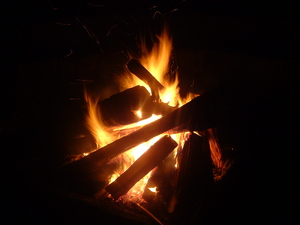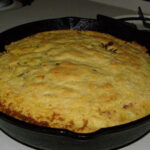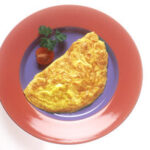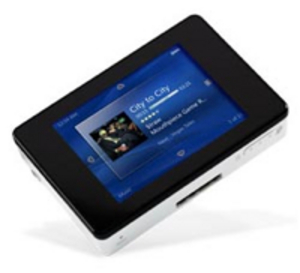Before 1100 C.E., most pots were made from bronze, but shortly after the invention of iron, a new cooking medium was created. Cast iron means just that, iron is poured into a mold to create a useful product (Source: Wikipedia). The mold itself is made of fine sand that has been hard packed to hold its shape. (Source: Holiday Cook).
Cast iron became extremely popular in the 1800s due to its versatility and ease of production. Cast iron cooks evenly even over an uneven heat source such as a campfire. Though it is slow to heat, it will retain its heat will cooking. Further, it can do just about anything from searing a steak and frying hamburgers to cooking an omelet to even backing a cake.
You can purchase a cast iron ban from just about any store, even a few hardware and camping stores carry them. Pick out a pan that you can comfortably use. Generally, 12″ is a good size. If you are shopping at your flea market or garage sales and find one that has seen better days, do not despair, you can give that pan a new life. The only thing you have to examine the pan for is to make sure that it is not cracked, nicked, chipped, or damaged in anyway.
This section of the article is for those who found a rusted cast iron pan at your local flea market or it was handed down to you. Time to bring it back to life. To restore the pan, there are three methods:
1. You can use steel wool, a palm sander with 70 to 80 grit sandpaper or a wire brush attachment on a drill, whichever you feel comfortable using. This will remove the dust and rust until the pan is smooth inside and out.
2. You can soak the pan in a solution of one part vinegar and ten parts water over night. This will loosen the dirt and rust then you can continue with sanding until the pan is smooth and free of debris. (Source: “Restoring and Caring for Cast Iron Cookware” by Delores Baugher)
3. If your pan shows no signs of rust and you have a self-cleaning over, you can complete two tasks at one time. Set your cast iron pan on the center rack and run your oven’s self-cleaning cycle. Let the pan cool completely in the oven before trying to handle it. (Source: What’s Cooking America)
Now that the pan is clean, it is time to “season” the pan to create its non-stick surface. This also holds true if you have purchased a new cast iron pan. To season a cast iron pan:
1. Wash in hot (as hot as you can handle) water and mild dish soap. Dry thoroughly inside and out.
2. Using either lard or bacon grease (do not use vegetable oil as it will leave a sticky film), coat the inside and outside of the pan. Place pan in a foil lined oven (cover the lower grate with foil and place the pan on the grate above) that has been preheated to 250˚ to 300˚.
3. After 15 minutes, carefully pull out the pan and pour off any excess oil and return to the oven for two hours. Repeating the removing the excess oil as needed. Allow to cool completely. Ready to use. (Source: Suite 101)
Some tips to remember when using cast iron:
1. The first few times you use the pan, choose high fat foods, such as bacon or hamburgers, to help strengthen its non-stick capabilities. (Source: Suite 101)
2. After each use, use hot water and steel wool to gently remove food particles. Do not use dish soap and do not submerge into water.
3. If you must use dish soap, use only a very small amount and use it quickly. Once done, make sure the pan is completely dry and you will again have to re-season the pan with either lard or bacon grease.
4. Store in a dark, dry area and do not place a lid on the pan. This will help air circulation and prevent rust.





